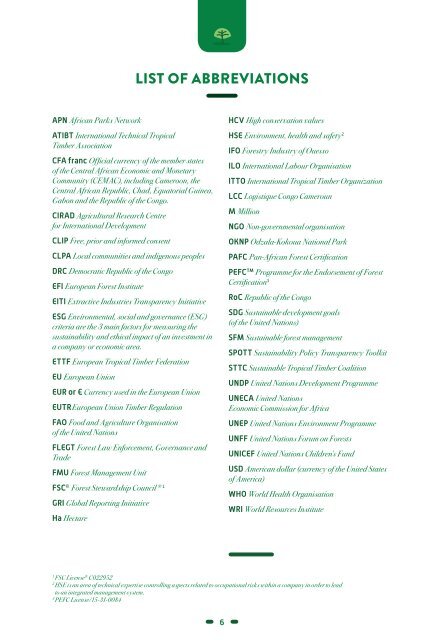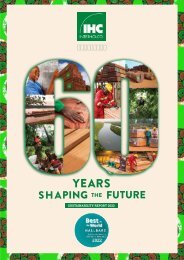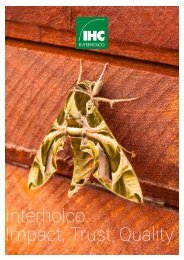An ALLIANCE culture to safeguard Africa's forests
INTERHOLCO invites you to discover "SUSTAINABLE HARDWOOD, MADE IN AFRICA" and the solutions it offers for meeting the major challenges facing the planet. A forest is so much more than just its trees. She is the nurturing mother and source of healing for the local communities and indigenous peoples who have interacted with her over the course of thousands of years. She is the land where their identities, relationships, traditions and cultures come to life; the sacred being animated by their hopes for the future. She is home to thousands of species, from fungi to insects, from birds to gorillas. She regulates the water cycle and the formation of the rainfall that is so critical to the balance of the climate and the survival of the Earth. She offers the world's population a revolutionary material: wood. Known and used since antiquity, it is the only building material that is healthy, natural, sustainable, traceable, recyclable, renewable and carbon positive. See you on our web site: www.interholco.com
INTERHOLCO invites you to discover "SUSTAINABLE HARDWOOD, MADE IN AFRICA" and the solutions it offers for meeting the major challenges facing the planet.
A forest is so much more than just its trees. She is the nurturing mother and source of healing for the local communities and indigenous peoples who have interacted with her over the course of thousands of years. She is the land where their identities, relationships, traditions and cultures come to life; the sacred being animated by their hopes for the future. She is home to thousands of species, from fungi to insects, from birds to gorillas. She regulates the water cycle and the formation of the rainfall that is so critical to the balance of the climate and the survival of the Earth. She offers the world's population a revolutionary material: wood. Known and used since antiquity, it is the only building material that is healthy, natural, sustainable, traceable, recyclable, renewable and carbon positive.
See you on our web site: www.interholco.com
Create successful ePaper yourself
Turn your PDF publications into a flip-book with our unique Google optimized e-Paper software.
LIST OF ABBREVIATIONS<br />
NOTES ON THIS REPORT<br />
APN African Parks Network<br />
ATIBT International Technical Tropical<br />
Timber Association<br />
CFA franc Official currency of the member states<br />
of the Central African Economic and Monetary<br />
Community (CEMAC), including Cameroon, the<br />
Central African Republic, Chad, Equa<strong>to</strong>rial Guinea,<br />
Gabon and the Republic of the Congo.<br />
CIRAD Agricultural Research Centre<br />
for International Development<br />
CLIP Free, prior and informed consent<br />
CLPA Local communities and indigenous peoples<br />
DRC Democratic Republic of the Congo<br />
EFI European Forest Institute<br />
EITI Extractive Industries Transparency Initiative<br />
ESG Environmental, social and governance (ESG)<br />
criteria are the 3 main fac<strong>to</strong>rs for measuring the<br />
sustainability and ethical impact of an investment in<br />
a company or economic area.<br />
ETTF European Tropical Timber Federation<br />
EU European Union<br />
EUR or ¤ Currency used in the European Union<br />
EUTREuropean Union Timber Regulation<br />
FAO Food and Agri<strong>culture</strong> Organisation<br />
of the United Nations<br />
FLEGT Forest Law Enforcement, Governance and<br />
Trade<br />
FMU Forest Management Unit<br />
FSC © Forest Stewardship Council ® 1<br />
GRI Global Reporting Initiative<br />
Ha Hectare<br />
HCV High conservation values<br />
HSE Environment, health and safety 2 <br />
IFO Forestry Industry of Ouesso<br />
ILO International Labour Organisation<br />
ITTO International Tropical Timber Organization<br />
LCC Logistique Congo Cameroun<br />
M Million<br />
NGO Non-governmental organisation<br />
OKNP Odzala-Kokoua National Park<br />
PAFC Pan-African Forest Certification<br />
PEFC TM Programme for the Endorsement of Forest<br />
Certification 3<br />
RoC Republic of the Congo<br />
SDG Sustainable development goals<br />
(of the United Nations)<br />
SFM Sustainable forest management<br />
SPOTT Sustainability Policy Transparency Toolkit<br />
STTC Sustainable Tropical Timber Coalition<br />
UNDP United Nations Development Programme<br />
UNECA United Nations<br />
Economic Commission for Africa<br />
UNEP United Nations Environment Programme<br />
UNFF United Nations Forum on Forests<br />
UNICEF United Nations Children's Fund<br />
USD American dollar (currency of the United States<br />
of America)<br />
WHO World Health Organisation<br />
WRI World Resources Institute<br />
1<br />
FSC License ® C022952<br />
2 <br />
HSE is an area of technical expertise controlling aspects related <strong>to</strong> occupational risks within a company in order <strong>to</strong> lead<br />
<strong>to</strong> an integrated management system.<br />
3<br />
PEFC License/15-31-0084<br />
This report covers INTERHOLCO's operations<br />
for the period 2017-2019 (financial year<br />
ending 31 December 2019). Data for 2014-<br />
2016 are incorporated in<strong>to</strong> the 2017-2019 data<br />
in the Appendices in order <strong>to</strong> identify existing<br />
trends. This report contains data for whollyowned<br />
enterprises and subsidiaries, but excludes<br />
suppliers of goods and services, unless otherwise<br />
specified. The next INTERHOLCO sustainability<br />
report is planned for 2022.<br />
INTERHOLCO's modus operandi is structured<br />
around an environmental landscape, a<br />
social landscape, an economic landscape<br />
and a regula<strong>to</strong>ry landscape. In the absence<br />
of a single frame of reference capable of<br />
incorporating all these landscapes, the 2020<br />
Sustainability Report presents the aspects that<br />
INTERHOLCO has measured in each landscape<br />
according <strong>to</strong> the 10 Principles of the UN<br />
Global Compact focusing on human rights,<br />
labour, the environment and anti-corruption;<br />
the Sustainable Development Goals of the<br />
United Nations (SDG); Pope Francis’ encyclical<br />
Lauda<strong>to</strong> Si’, which focuses on <strong>safeguard</strong>ing<br />
the Earth, our common home; the handbook<br />
“Vocation of the Business Leader: A Reflection“,<br />
targeting business leaders seeking <strong>to</strong> integrate<br />
their faith in<strong>to</strong> their work; the FAO’s analysis on<br />
“The State of the World’s Forests 2018, Forest<br />
Pathways <strong>to</strong> Sustainable Development“; the<br />
voluntary guidelines drawn up by the EFI and<br />
the FAO “Making forest concessions in the<br />
tropics work <strong>to</strong> achieve the 2030 Agenda”; the<br />
FAO's Global Forest Resources Assessment; the<br />
reflections and proposals for the formulation<br />
and implementation of strategies for the<br />
development of the forestry industry in the Congo<br />
Basin, contained in the FAO white paper; the<br />
principles and standards of FSC environmental<br />
certification © ; PEFC TM certification standards<br />
including the PAFC initiative being developed in<br />
the Congo Basin; the laws in force in Cameroon,<br />
the Republic of the Congo and Switzerland - in<br />
particular, compliance with the forestry laws of<br />
the Republic of Congo, based on the indica<strong>to</strong>rs<br />
developed by the EITI; the Conclusions of<br />
the Council and of the Governments of the<br />
Member States sitting in the Council on the<br />
Communication on Stepping Up EU Action <strong>to</strong><br />
Protect and Res<strong>to</strong>re the World’s Forests”; the<br />
European Union Timber Regulation (EUTR) as part<br />
of the FLEGT initiative; the statistics published<br />
by the Independent Market Moni<strong>to</strong>ring Unit of<br />
the FLEGT scheme as well as those published by<br />
the ITTO; the social-environmental reporting<br />
standards established by the Global Reporting<br />
Initiative (GRI) (see GRI Content Index on p. 108:<br />
this report is not externally audited), an initiative<br />
supported by the United Nations Environment<br />
Programme (UNEP); ATIBT’s General Tropical<br />
Timber Nomenclature; data from Global Forest<br />
Watch, the moni<strong>to</strong>ring platform developed by the<br />
World Resources Institute (WRI) with state-ofthe-art<br />
technology; the comparative benchmark<br />
developed by the NGO Greenpeace with the<br />
Naturwald Akademie as part of its vision for the<br />
climate, people and nature “Wenn Wälder Wieder<br />
Wachsen“ (‘When Forests Grow Again’); and, of<br />
course, the environmental, social and governance<br />
transparency indica<strong>to</strong>rs at the heart of SPOTT,<br />
an initiative spearheaded by the British NGO<br />
Zoological Society of London, designed <strong>to</strong> gain a<br />
better understanding of the performance of 100<br />
timber and cellulose companies operating in the<br />
tropics.<br />
In order <strong>to</strong> make reading this report easier,<br />
we have adopted the same colour code as<br />
in the 2017 Report, i.e.:<br />
pink --> social landscape<br />
green --> environmental landscape<br />
blue --> economic landscape<br />
brown --> regula<strong>to</strong>ry landscape<br />
6<br />
7














